Competitive Strategy Analysis: Higher Education Business Models Report
VerifiedAdded on 2020/06/06
|8
|1786
|447
Report
AI Summary
This report provides a comprehensive analysis of competitive strategies within the higher education sector. It begins by exploring the development of competitive strategies, emphasizing the need for unique ideas to achieve success in the market. The report delves into the significance of business model innovation, highlighting how institutions can learn from others and reinvent their own models to gain a competitive advantage. It also examines the CAGE framework, discussing cultural, administrative/political, geographic, and economic factors that influence the operations of educational institutions. The report concludes by emphasizing the crucial role of strategies in achieving organizational goals and the importance of business model innovation for the advancement of the higher education industry. The analysis covers where to compete, unique value, sources of capability, sustainability, initiation, ideation, integration, and implementation of business models.
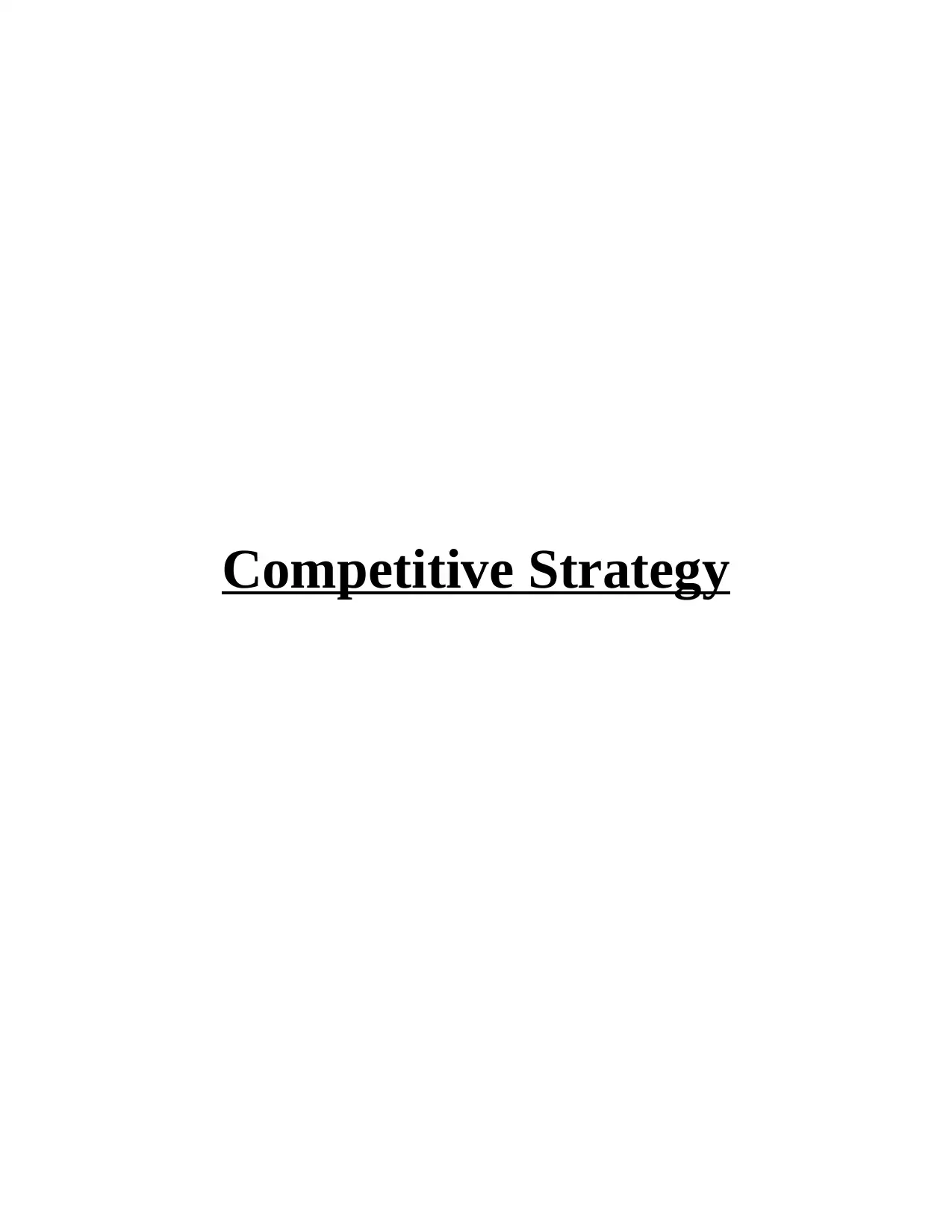
Competitive Strategy
Paraphrase This Document
Need a fresh take? Get an instant paraphrase of this document with our AI Paraphraser
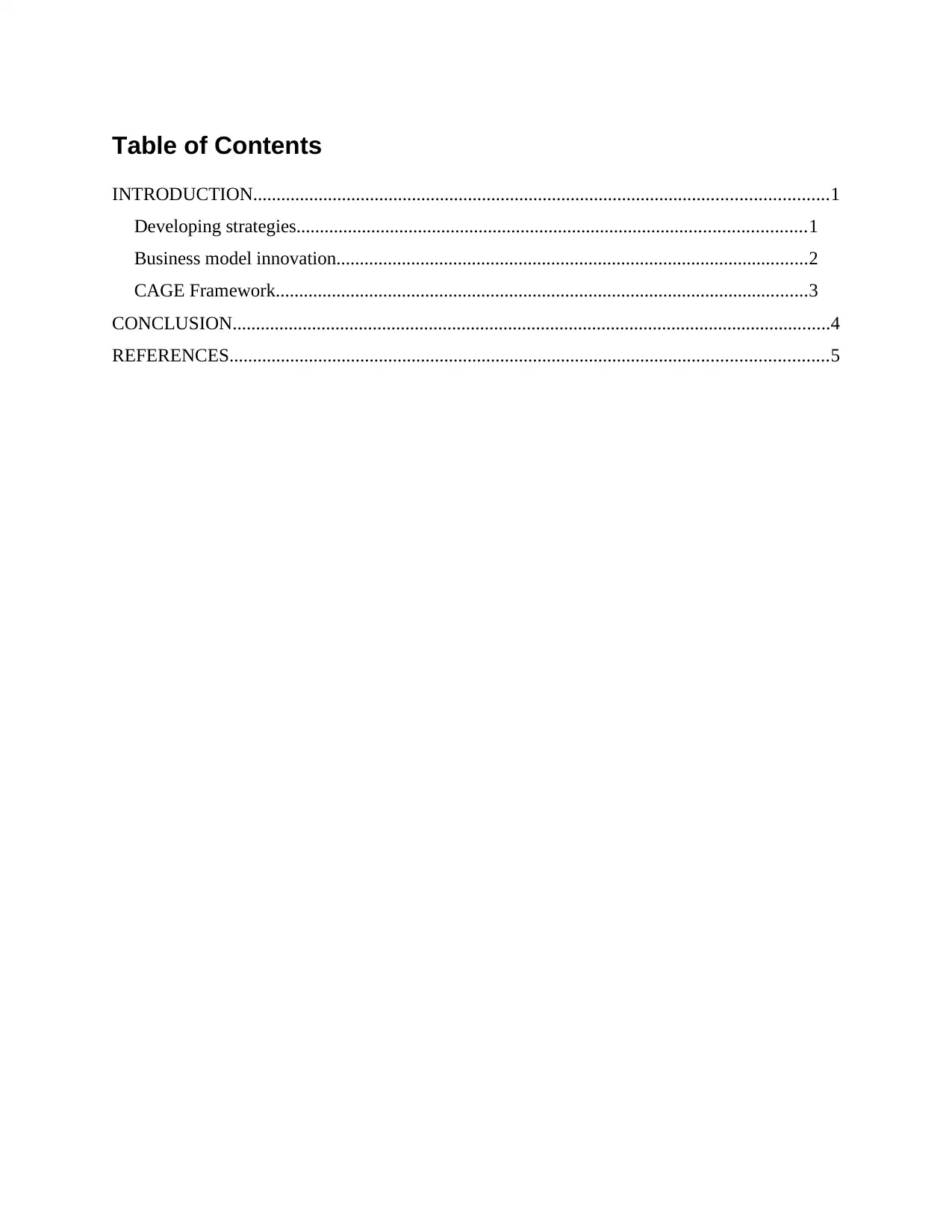
Table of Contents
INTRODUCTION...........................................................................................................................1
Developing strategies.............................................................................................................1
Business model innovation.....................................................................................................2
CAGE Framework..................................................................................................................3
CONCLUSION................................................................................................................................4
REFERENCES................................................................................................................................5
INTRODUCTION...........................................................................................................................1
Developing strategies.............................................................................................................1
Business model innovation.....................................................................................................2
CAGE Framework..................................................................................................................3
CONCLUSION................................................................................................................................4
REFERENCES................................................................................................................................5
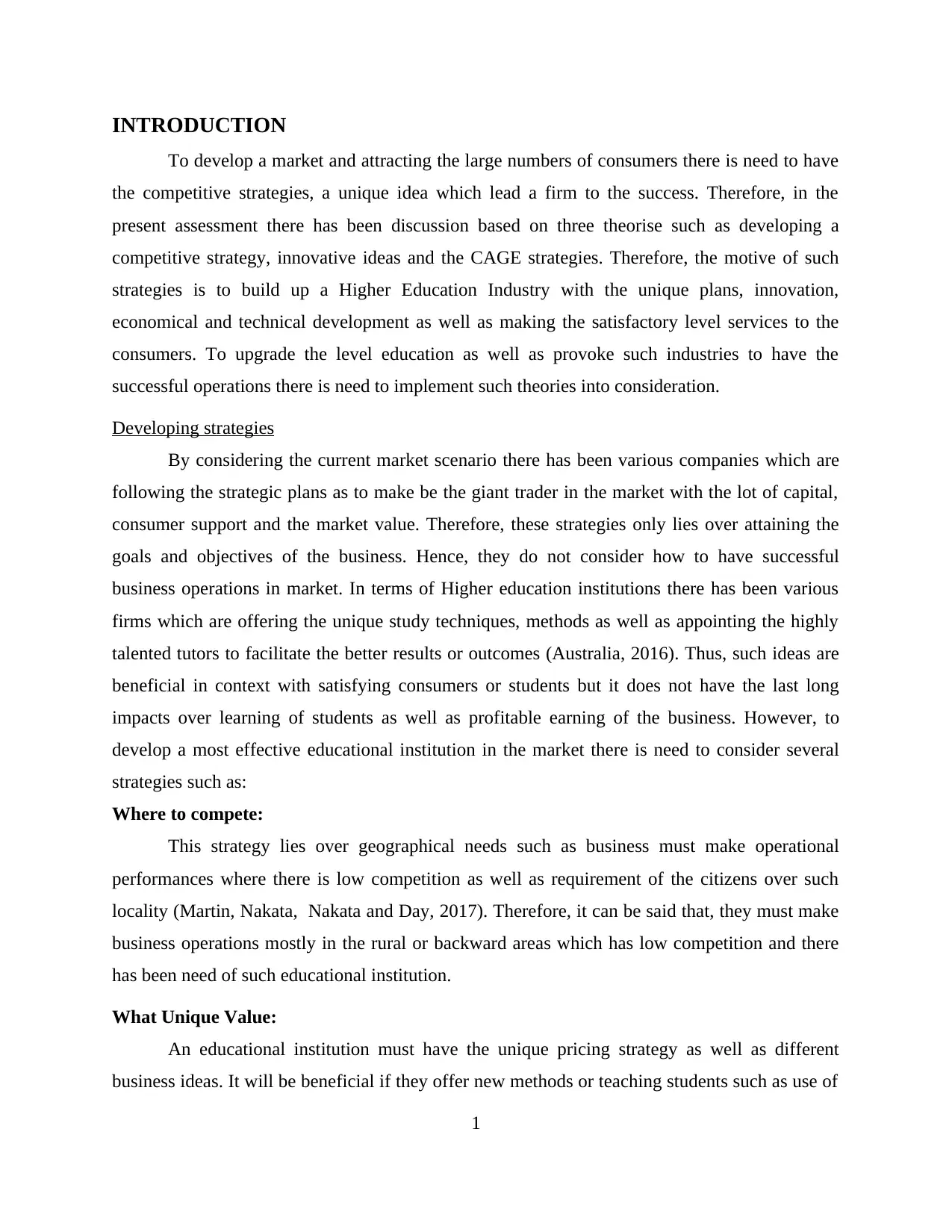
INTRODUCTION
To develop a market and attracting the large numbers of consumers there is need to have
the competitive strategies, a unique idea which lead a firm to the success. Therefore, in the
present assessment there has been discussion based on three theorise such as developing a
competitive strategy, innovative ideas and the CAGE strategies. Therefore, the motive of such
strategies is to build up a Higher Education Industry with the unique plans, innovation,
economical and technical development as well as making the satisfactory level services to the
consumers. To upgrade the level education as well as provoke such industries to have the
successful operations there is need to implement such theories into consideration.
Developing strategies
By considering the current market scenario there has been various companies which are
following the strategic plans as to make be the giant trader in the market with the lot of capital,
consumer support and the market value. Therefore, these strategies only lies over attaining the
goals and objectives of the business. Hence, they do not consider how to have successful
business operations in market. In terms of Higher education institutions there has been various
firms which are offering the unique study techniques, methods as well as appointing the highly
talented tutors to facilitate the better results or outcomes (Australia, 2016). Thus, such ideas are
beneficial in context with satisfying consumers or students but it does not have the last long
impacts over learning of students as well as profitable earning of the business. However, to
develop a most effective educational institution in the market there is need to consider several
strategies such as:
Where to compete:
This strategy lies over geographical needs such as business must make operational
performances where there is low competition as well as requirement of the citizens over such
locality (Martin, Nakata, Nakata and Day, 2017). Therefore, it can be said that, they must make
business operations mostly in the rural or backward areas which has low competition and there
has been need of such educational institution.
What Unique Value:
An educational institution must have the unique pricing strategy as well as different
business ideas. It will be beneficial if they offer new methods or teaching students such as use of
1
To develop a market and attracting the large numbers of consumers there is need to have
the competitive strategies, a unique idea which lead a firm to the success. Therefore, in the
present assessment there has been discussion based on three theorise such as developing a
competitive strategy, innovative ideas and the CAGE strategies. Therefore, the motive of such
strategies is to build up a Higher Education Industry with the unique plans, innovation,
economical and technical development as well as making the satisfactory level services to the
consumers. To upgrade the level education as well as provoke such industries to have the
successful operations there is need to implement such theories into consideration.
Developing strategies
By considering the current market scenario there has been various companies which are
following the strategic plans as to make be the giant trader in the market with the lot of capital,
consumer support and the market value. Therefore, these strategies only lies over attaining the
goals and objectives of the business. Hence, they do not consider how to have successful
business operations in market. In terms of Higher education institutions there has been various
firms which are offering the unique study techniques, methods as well as appointing the highly
talented tutors to facilitate the better results or outcomes (Australia, 2016). Thus, such ideas are
beneficial in context with satisfying consumers or students but it does not have the last long
impacts over learning of students as well as profitable earning of the business. However, to
develop a most effective educational institution in the market there is need to consider several
strategies such as:
Where to compete:
This strategy lies over geographical needs such as business must make operational
performances where there is low competition as well as requirement of the citizens over such
locality (Martin, Nakata, Nakata and Day, 2017). Therefore, it can be said that, they must make
business operations mostly in the rural or backward areas which has low competition and there
has been need of such educational institution.
What Unique Value:
An educational institution must have the unique pricing strategy as well as different
business ideas. It will be beneficial if they offer new methods or teaching students such as use of
1
⊘ This is a preview!⊘
Do you want full access?
Subscribe today to unlock all pages.

Trusted by 1+ million students worldwide
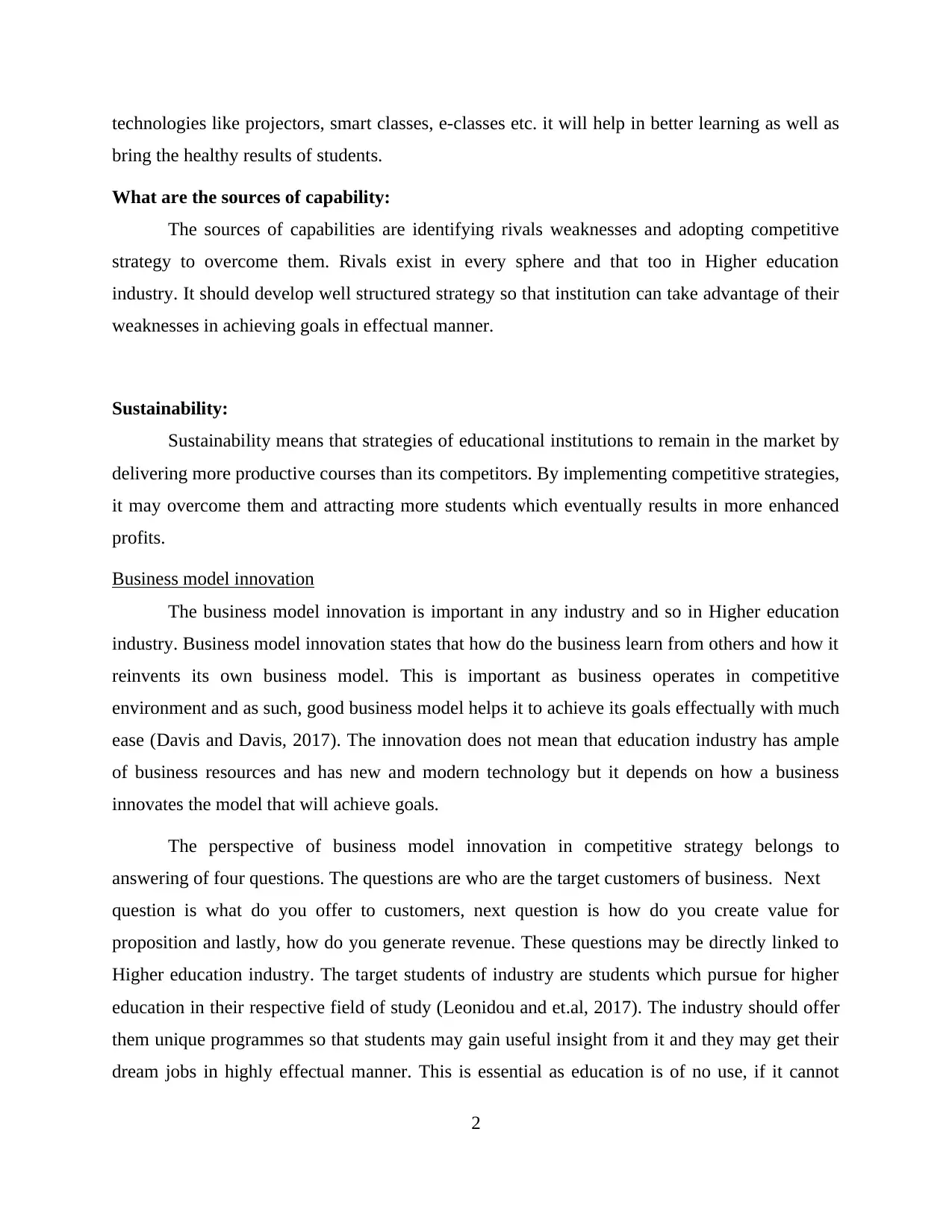
technologies like projectors, smart classes, e-classes etc. it will help in better learning as well as
bring the healthy results of students.
What are the sources of capability:
The sources of capabilities are identifying rivals weaknesses and adopting competitive
strategy to overcome them. Rivals exist in every sphere and that too in Higher education
industry. It should develop well structured strategy so that institution can take advantage of their
weaknesses in achieving goals in effectual manner.
Sustainability:
Sustainability means that strategies of educational institutions to remain in the market by
delivering more productive courses than its competitors. By implementing competitive strategies,
it may overcome them and attracting more students which eventually results in more enhanced
profits.
Business model innovation
The business model innovation is important in any industry and so in Higher education
industry. Business model innovation states that how do the business learn from others and how it
reinvents its own business model. This is important as business operates in competitive
environment and as such, good business model helps it to achieve its goals effectually with much
ease (Davis and Davis, 2017). The innovation does not mean that education industry has ample
of business resources and has new and modern technology but it depends on how a business
innovates the model that will achieve goals.
The perspective of business model innovation in competitive strategy belongs to
answering of four questions. The questions are who are the target customers of business. Next
question is what do you offer to customers, next question is how do you create value for
proposition and lastly, how do you generate revenue. These questions may be directly linked to
Higher education industry. The target students of industry are students which pursue for higher
education in their respective field of study (Leonidou and et.al, 2017). The industry should offer
them unique programmes so that students may gain useful insight from it and they may get their
dream jobs in highly effectual manner. This is essential as education is of no use, if it cannot
2
bring the healthy results of students.
What are the sources of capability:
The sources of capabilities are identifying rivals weaknesses and adopting competitive
strategy to overcome them. Rivals exist in every sphere and that too in Higher education
industry. It should develop well structured strategy so that institution can take advantage of their
weaknesses in achieving goals in effectual manner.
Sustainability:
Sustainability means that strategies of educational institutions to remain in the market by
delivering more productive courses than its competitors. By implementing competitive strategies,
it may overcome them and attracting more students which eventually results in more enhanced
profits.
Business model innovation
The business model innovation is important in any industry and so in Higher education
industry. Business model innovation states that how do the business learn from others and how it
reinvents its own business model. This is important as business operates in competitive
environment and as such, good business model helps it to achieve its goals effectually with much
ease (Davis and Davis, 2017). The innovation does not mean that education industry has ample
of business resources and has new and modern technology but it depends on how a business
innovates the model that will achieve goals.
The perspective of business model innovation in competitive strategy belongs to
answering of four questions. The questions are who are the target customers of business. Next
question is what do you offer to customers, next question is how do you create value for
proposition and lastly, how do you generate revenue. These questions may be directly linked to
Higher education industry. The target students of industry are students which pursue for higher
education in their respective field of study (Leonidou and et.al, 2017). The industry should offer
them unique programmes so that students may gain useful insight from it and they may get their
dream jobs in highly effectual manner. This is essential as education is of no use, if it cannot
2
Paraphrase This Document
Need a fresh take? Get an instant paraphrase of this document with our AI Paraphraser
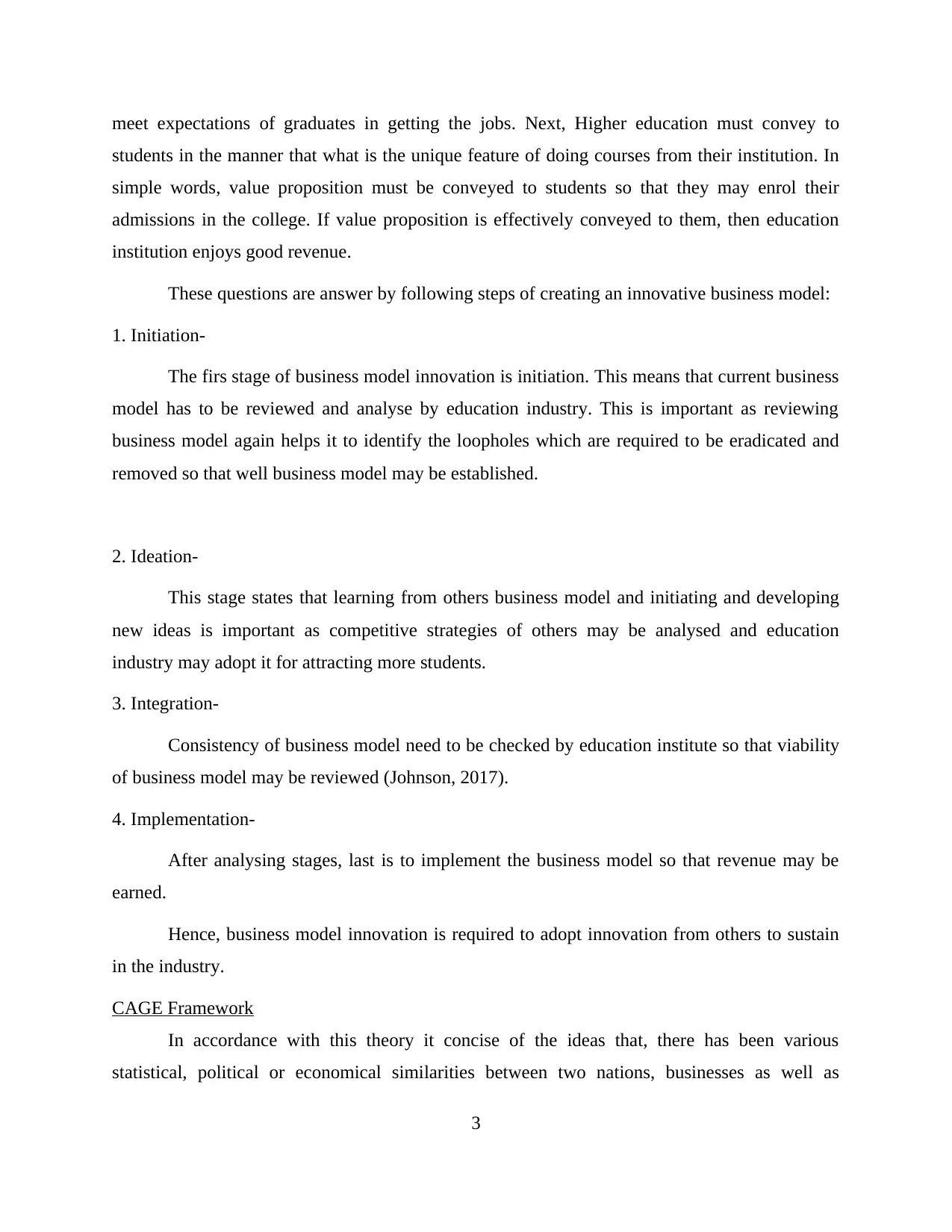
meet expectations of graduates in getting the jobs. Next, Higher education must convey to
students in the manner that what is the unique feature of doing courses from their institution. In
simple words, value proposition must be conveyed to students so that they may enrol their
admissions in the college. If value proposition is effectively conveyed to them, then education
institution enjoys good revenue.
These questions are answer by following steps of creating an innovative business model:
1. Initiation-
The firs stage of business model innovation is initiation. This means that current business
model has to be reviewed and analyse by education industry. This is important as reviewing
business model again helps it to identify the loopholes which are required to be eradicated and
removed so that well business model may be established.
2. Ideation-
This stage states that learning from others business model and initiating and developing
new ideas is important as competitive strategies of others may be analysed and education
industry may adopt it for attracting more students.
3. Integration-
Consistency of business model need to be checked by education institute so that viability
of business model may be reviewed (Johnson, 2017).
4. Implementation-
After analysing stages, last is to implement the business model so that revenue may be
earned.
Hence, business model innovation is required to adopt innovation from others to sustain
in the industry.
CAGE Framework
In accordance with this theory it concise of the ideas that, there has been various
statistical, political or economical similarities between two nations, businesses as well as
3
students in the manner that what is the unique feature of doing courses from their institution. In
simple words, value proposition must be conveyed to students so that they may enrol their
admissions in the college. If value proposition is effectively conveyed to them, then education
institution enjoys good revenue.
These questions are answer by following steps of creating an innovative business model:
1. Initiation-
The firs stage of business model innovation is initiation. This means that current business
model has to be reviewed and analyse by education industry. This is important as reviewing
business model again helps it to identify the loopholes which are required to be eradicated and
removed so that well business model may be established.
2. Ideation-
This stage states that learning from others business model and initiating and developing
new ideas is important as competitive strategies of others may be analysed and education
industry may adopt it for attracting more students.
3. Integration-
Consistency of business model need to be checked by education institute so that viability
of business model may be reviewed (Johnson, 2017).
4. Implementation-
After analysing stages, last is to implement the business model so that revenue may be
earned.
Hence, business model innovation is required to adopt innovation from others to sustain
in the industry.
CAGE Framework
In accordance with this theory it concise of the ideas that, there has been various
statistical, political or economical similarities between two nations, businesses as well as
3
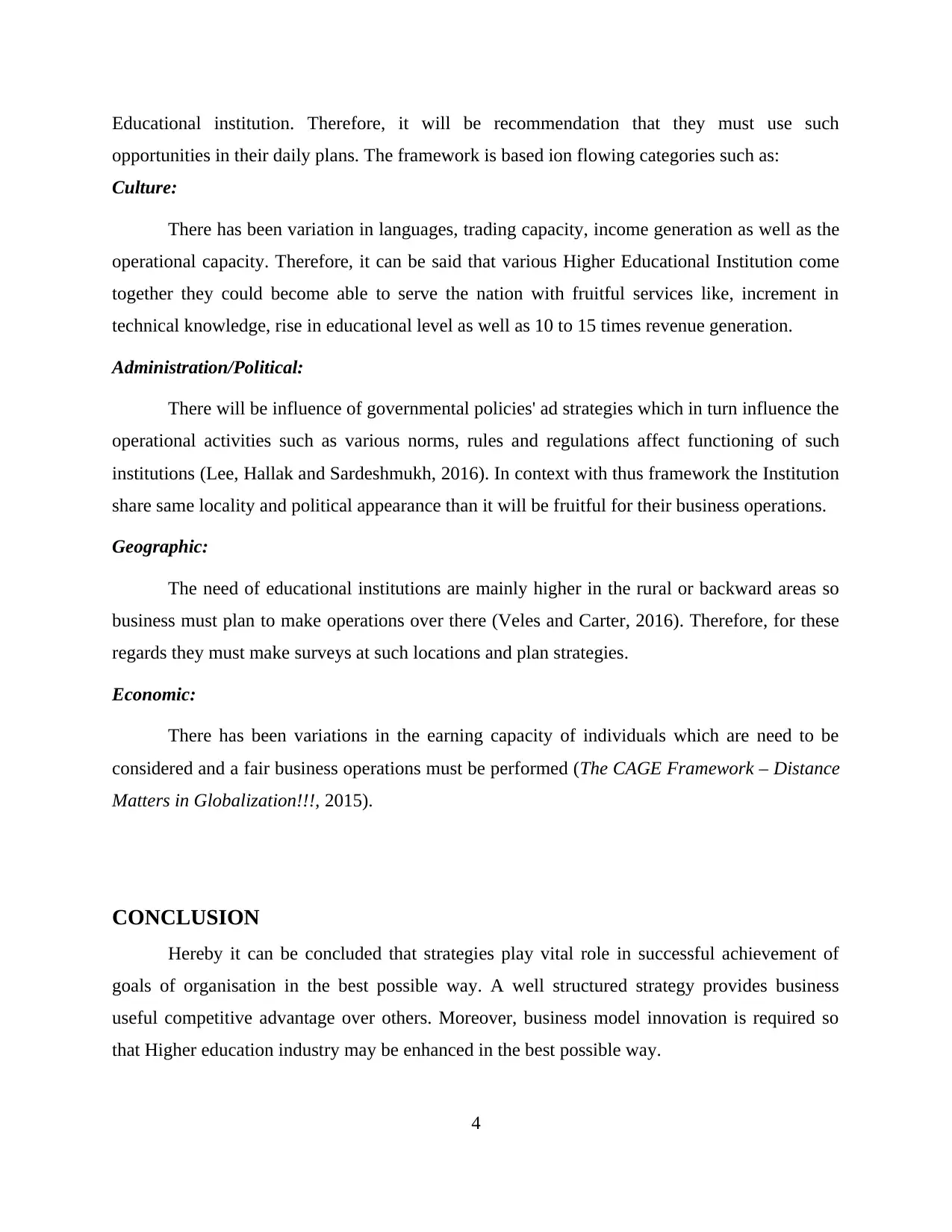
Educational institution. Therefore, it will be recommendation that they must use such
opportunities in their daily plans. The framework is based ion flowing categories such as:
Culture:
There has been variation in languages, trading capacity, income generation as well as the
operational capacity. Therefore, it can be said that various Higher Educational Institution come
together they could become able to serve the nation with fruitful services like, increment in
technical knowledge, rise in educational level as well as 10 to 15 times revenue generation.
Administration/Political:
There will be influence of governmental policies' ad strategies which in turn influence the
operational activities such as various norms, rules and regulations affect functioning of such
institutions (Lee, Hallak and Sardeshmukh, 2016). In context with thus framework the Institution
share same locality and political appearance than it will be fruitful for their business operations.
Geographic:
The need of educational institutions are mainly higher in the rural or backward areas so
business must plan to make operations over there (Veles and Carter, 2016). Therefore, for these
regards they must make surveys at such locations and plan strategies.
Economic:
There has been variations in the earning capacity of individuals which are need to be
considered and a fair business operations must be performed (The CAGE Framework – Distance
Matters in Globalization!!!, 2015).
CONCLUSION
Hereby it can be concluded that strategies play vital role in successful achievement of
goals of organisation in the best possible way. A well structured strategy provides business
useful competitive advantage over others. Moreover, business model innovation is required so
that Higher education industry may be enhanced in the best possible way.
4
opportunities in their daily plans. The framework is based ion flowing categories such as:
Culture:
There has been variation in languages, trading capacity, income generation as well as the
operational capacity. Therefore, it can be said that various Higher Educational Institution come
together they could become able to serve the nation with fruitful services like, increment in
technical knowledge, rise in educational level as well as 10 to 15 times revenue generation.
Administration/Political:
There will be influence of governmental policies' ad strategies which in turn influence the
operational activities such as various norms, rules and regulations affect functioning of such
institutions (Lee, Hallak and Sardeshmukh, 2016). In context with thus framework the Institution
share same locality and political appearance than it will be fruitful for their business operations.
Geographic:
The need of educational institutions are mainly higher in the rural or backward areas so
business must plan to make operations over there (Veles and Carter, 2016). Therefore, for these
regards they must make surveys at such locations and plan strategies.
Economic:
There has been variations in the earning capacity of individuals which are need to be
considered and a fair business operations must be performed (The CAGE Framework – Distance
Matters in Globalization!!!, 2015).
CONCLUSION
Hereby it can be concluded that strategies play vital role in successful achievement of
goals of organisation in the best possible way. A well structured strategy provides business
useful competitive advantage over others. Moreover, business model innovation is required so
that Higher education industry may be enhanced in the best possible way.
4
⊘ This is a preview!⊘
Do you want full access?
Subscribe today to unlock all pages.

Trusted by 1+ million students worldwide
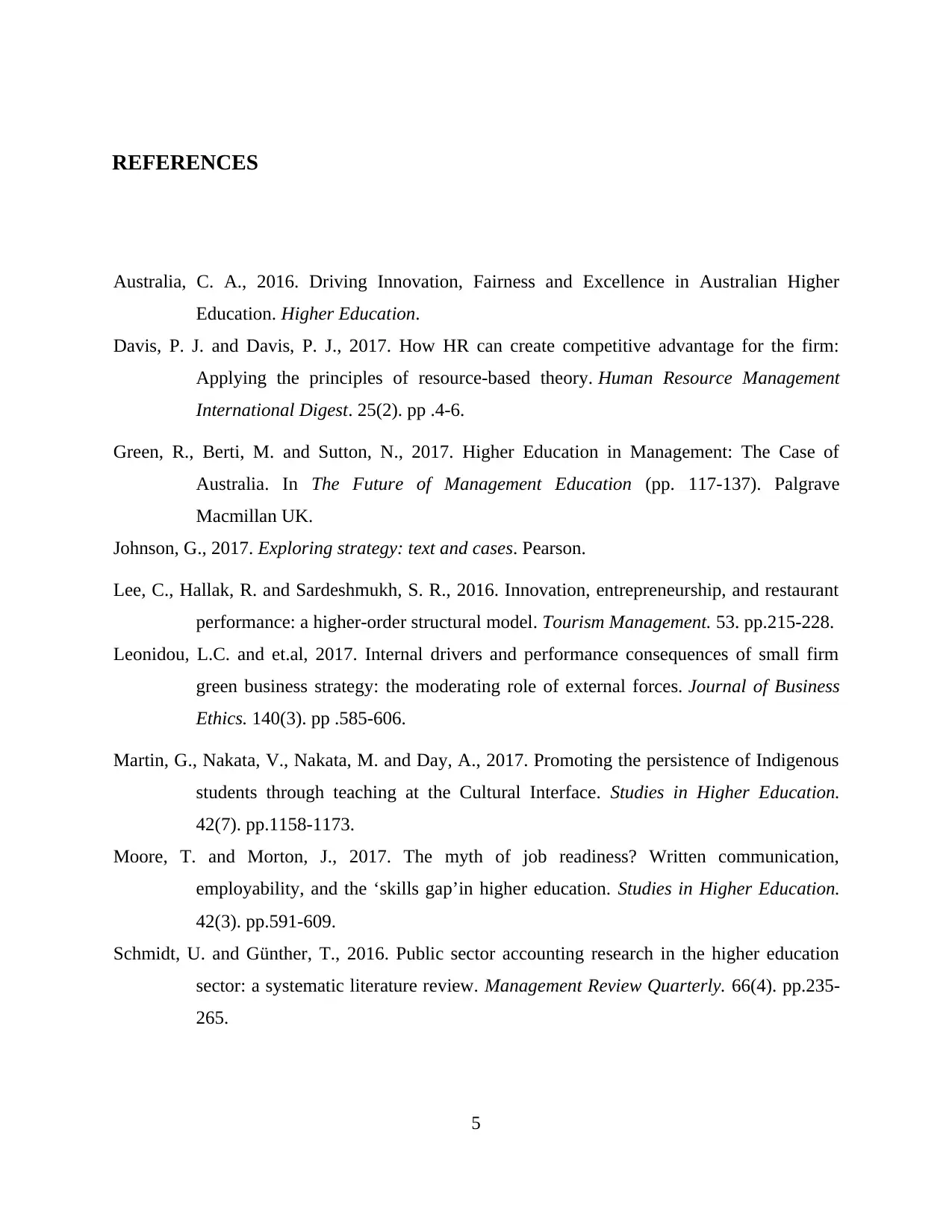
REFERENCES
Australia, C. A., 2016. Driving Innovation, Fairness and Excellence in Australian Higher
Education. Higher Education.
Davis, P. J. and Davis, P. J., 2017. How HR can create competitive advantage for the firm:
Applying the principles of resource-based theory. Human Resource Management
International Digest. 25(2). pp .4-6.
Green, R., Berti, M. and Sutton, N., 2017. Higher Education in Management: The Case of
Australia. In The Future of Management Education (pp. 117-137). Palgrave
Macmillan UK.
Johnson, G., 2017. Exploring strategy: text and cases. Pearson.
Lee, C., Hallak, R. and Sardeshmukh, S. R., 2016. Innovation, entrepreneurship, and restaurant
performance: a higher-order structural model. Tourism Management. 53. pp.215-228.
Leonidou, L.C. and et.al, 2017. Internal drivers and performance consequences of small firm
green business strategy: the moderating role of external forces. Journal of Business
Ethics. 140(3). pp .585-606.
Martin, G., Nakata, V., Nakata, M. and Day, A., 2017. Promoting the persistence of Indigenous
students through teaching at the Cultural Interface. Studies in Higher Education.
42(7). pp.1158-1173.
Moore, T. and Morton, J., 2017. The myth of job readiness? Written communication,
employability, and the ‘skills gap’in higher education. Studies in Higher Education.
42(3). pp.591-609.
Schmidt, U. and Günther, T., 2016. Public sector accounting research in the higher education
sector: a systematic literature review. Management Review Quarterly. 66(4). pp.235-
265.
5
Australia, C. A., 2016. Driving Innovation, Fairness and Excellence in Australian Higher
Education. Higher Education.
Davis, P. J. and Davis, P. J., 2017. How HR can create competitive advantage for the firm:
Applying the principles of resource-based theory. Human Resource Management
International Digest. 25(2). pp .4-6.
Green, R., Berti, M. and Sutton, N., 2017. Higher Education in Management: The Case of
Australia. In The Future of Management Education (pp. 117-137). Palgrave
Macmillan UK.
Johnson, G., 2017. Exploring strategy: text and cases. Pearson.
Lee, C., Hallak, R. and Sardeshmukh, S. R., 2016. Innovation, entrepreneurship, and restaurant
performance: a higher-order structural model. Tourism Management. 53. pp.215-228.
Leonidou, L.C. and et.al, 2017. Internal drivers and performance consequences of small firm
green business strategy: the moderating role of external forces. Journal of Business
Ethics. 140(3). pp .585-606.
Martin, G., Nakata, V., Nakata, M. and Day, A., 2017. Promoting the persistence of Indigenous
students through teaching at the Cultural Interface. Studies in Higher Education.
42(7). pp.1158-1173.
Moore, T. and Morton, J., 2017. The myth of job readiness? Written communication,
employability, and the ‘skills gap’in higher education. Studies in Higher Education.
42(3). pp.591-609.
Schmidt, U. and Günther, T., 2016. Public sector accounting research in the higher education
sector: a systematic literature review. Management Review Quarterly. 66(4). pp.235-
265.
5
Paraphrase This Document
Need a fresh take? Get an instant paraphrase of this document with our AI Paraphraser
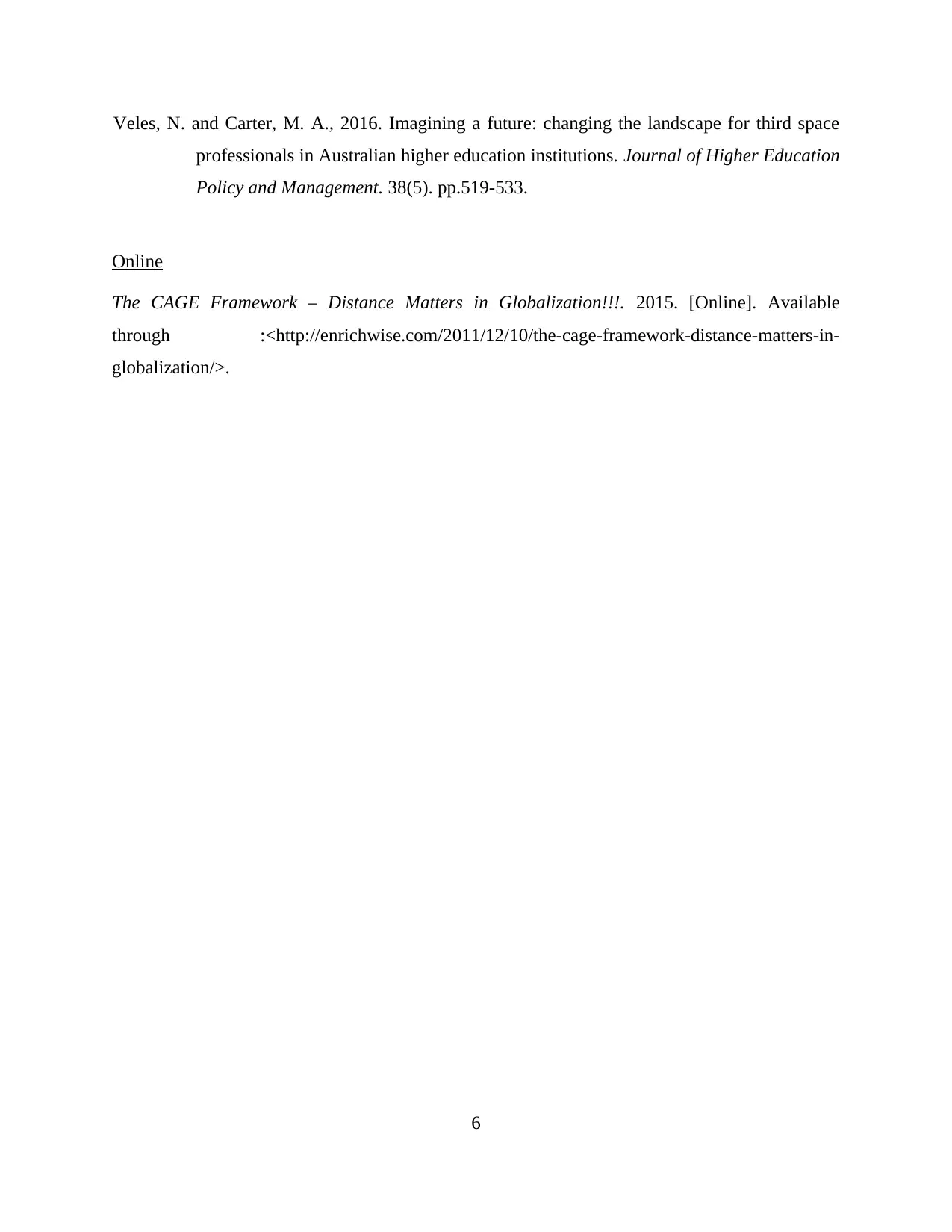
Veles, N. and Carter, M. A., 2016. Imagining a future: changing the landscape for third space
professionals in Australian higher education institutions. Journal of Higher Education
Policy and Management. 38(5). pp.519-533.
Online
The CAGE Framework – Distance Matters in Globalization!!!. 2015. [Online]. Available
through :<http://enrichwise.com/2011/12/10/the-cage-framework-distance-matters-in-
globalization/>.
6
professionals in Australian higher education institutions. Journal of Higher Education
Policy and Management. 38(5). pp.519-533.
Online
The CAGE Framework – Distance Matters in Globalization!!!. 2015. [Online]. Available
through :<http://enrichwise.com/2011/12/10/the-cage-framework-distance-matters-in-
globalization/>.
6
1 out of 8
Related Documents
Your All-in-One AI-Powered Toolkit for Academic Success.
+13062052269
info@desklib.com
Available 24*7 on WhatsApp / Email
![[object Object]](/_next/static/media/star-bottom.7253800d.svg)
Unlock your academic potential
Copyright © 2020–2025 A2Z Services. All Rights Reserved. Developed and managed by ZUCOL.




